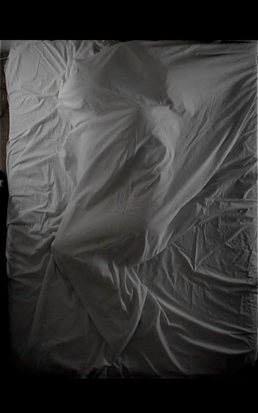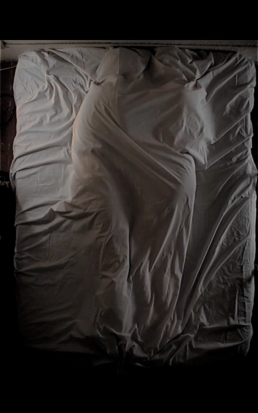CAMERA LUCIDA | LA CHAMBRE CLAIRE | DET LYSE KAMMER (v1.0) – 2010
A video installation © by jean-marie babonneau (1999-2010) – First exhibited at The Copenhagen Photo Festival 2010
CAMERA LUCIDA | LA CHAMBRE CLAIRE | DET LYSE KAMMER – v.1 (2010)
A video installation offering a space for immersion and contemplation about our past intimate relationships, about romantic love between two adults and its nostalgic traces in images – a tribute to Roland Barthes’ essay.
• TECHNICAL & LOGISTICS
A video installation in a darkened space (approx. min. Length 500 cm x Width 400 cm x Height 400 cm) with 3 video projectors (min. 2000 ansi – wide angle projectors depending on the in-situ distance), 3 DVD players (3 DVDs each containing a looped video: the bed, the window, the table), adjustable hanging system for the projectors and the players, a single double bed (140 or 160 cm mattress + crumpled white sheets in the top falling on the edges around the bed, a small sober wooden table with 4 legs (covered with a few sheets of blank white paper that will be projection frames on the table and a few ballpoint pens and black felt-tip pens), a simple wooden chair going with the table, a horizontal window frame in two leaves (glass covered with a matte translucent film for the rear projection of the landscape changing with the passing of the seasons), an audio amplifier and 2 discreet speakers and all the necessary wiring arranged in manner discreet without disturbing the movement of spectators in the space of the installation.
• PRESENTATION TEXT
The installation offers a contemplative daydream inside an automatic and poetic bedroom featuring simple elements: a double bed, a table (with a chair), a window, which serve as trompe-l’oeil (make-believe) projection surfaces.
• The Bed (PAL, 4:3, approx. 40 min.): a ghostly figure of a sleeper under the sheet, sometimes moves in his sleep during a dream which will periodically interrupt the image of the sleeper in the bed by replacing it with an accelerated sequence of a walk on the seaside in Reykjavík in Iceland. The very wide angle vision of the ballad reveals a hand holding handwritten sheets of paper, a love letter. Sometimes there are two figures in the bed.
• The Window (PAL, 4:3, approx. 10 min.): slide show of the same view of an urban landscape in Copenhagen (district of Christianshavn) changes according to the seasons and weather conditions (rain, clouds , snow, sun) and day and night cycles. The seasons pass and return in a loop.
• The Table (under development): slideshow of handwritten texts (diary notes, poems), drawings, sketches and photographs (masked faces, naked bodies) projected on sheets of white paper (blank) and possibly in a book blank pages open on the table (the video projection will turn the pages automatically). The spectator will be able to sit on the chair taking the subjective point of view of the absent and ghostly protagonist of the room.
• Optional in future versions: Wallpaper and photographs projected in empty frames on the walls (under development).
Thus the spectator will be able to visit the bedroom like a theater scene abandoned by the lovers, a reconstructed crime scene, an intimate bedroom that has become public.
A work of vain resistance against the passage of time. The work attempts the impossible between timelessness and ubiquity by combining sequences conceived and produced on different dates and in different places and countries:
– in Arles in 1999 (The Bed – The Phantom Sleepers #01),
– in Reykjavik in 2002 (The Bed – The Dream #01),
– in Copenhagen in 2009-2010 (The Window #01).
A monument to the glory of fallen loves and departed loved ones, a place of memory sublimated and turned into a cult space. Almost a temple, a place of worship where perhaps a remnant of the famous “aura” still remains. The installation also plays with the notion of a magical room, functioning in the absence of its occupants become ghosts, like a pumpkin transformed into a carriage for Cinderella before the fateful hour of midnight. Van Gogh painted his bedroom and today would perhaps have traded his brushes for small machines, cameras, video cameras and illusion projectors. What remains of our bygone relationships? What is there to pass on to our children of our intimate human story and the lessons we have learned from life? Here is a piece questioning the universality of our sentimental apprenticeship, our relationship between the intimate and the public.
Jean-Marie Babonneau
May 2010
—




